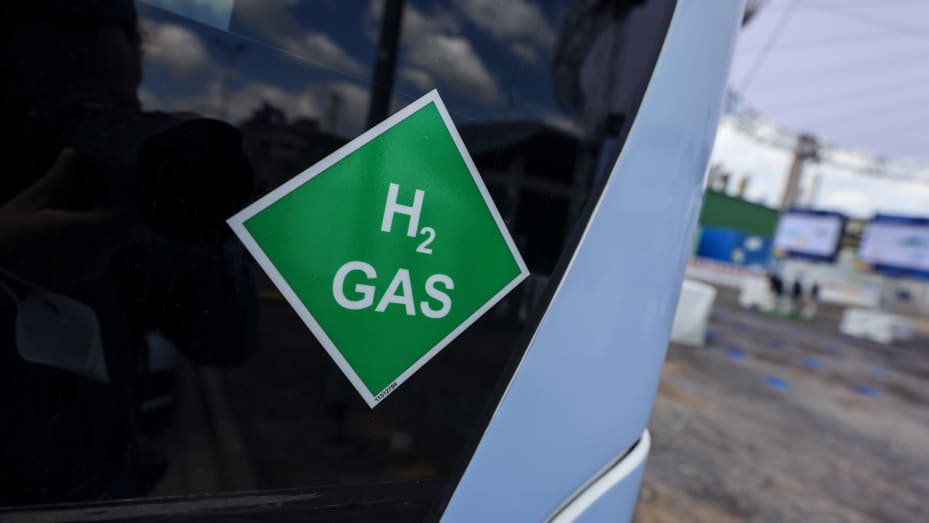* * * * * * * *
 |
At MITEI’s 2022 Spring Symposium, the “Options for producing low-carbon hydrogen at scale” panel laid out existing and planned efforts to produce hydrogen at scale to help achieve a decarbonized energy system. | Credits:Photo: Kelley Travers |
Making hydrogen power a reality
by Calvin Hennick | MIT Energy Initiative
June 27, 2022
Hydrogen fuel has long been seen as a potentially key component of a carbon-neutral future. At the 2022 MIT Energy Initiative Spring Symposium, industry experts describe efforts to produce it at scale.
For decades, government and industry have looked to hydrogen as a potentially game-changing tool in the quest for clean energy. As far back as the early days of the Clinton administration, energy sector observers and public policy experts have extolled the virtues of hydrogen — to the point that some people have joked that hydrogen is the energy of the future, “and always will be.”
Even as wind and solar power have become commonplace in recent years, hydrogen has been held back by high costs and other challenges. But the fuel may finally be poised to have its moment. At the MIT Energy Initiative Spring Symposium — entitled “Hydrogen’s role in a decarbonized energy system” — experts discussed hydrogen production routes, hydrogen consumption markets, the path to a robust hydrogen infrastructure, and policy changes needed to achieve a “hydrogen future.”
During one panel, “Options for producing low-carbon hydrogen at scale,” four experts laid out existing and planned efforts to leverage hydrogen for decarbonization.
“The race is on”
Huyen N. Dinh, a senior scientist and group manager at the National Renewable Energy Laboratory (NREL), is the director of HydroGEN, a consortium of several U.S. Department of Energy (DOE) national laboratories that accelerates research and development of innovative and advanced water splitting materials and technologies for clean, sustainable, and low-cost hydrogen production.
For the past 14 years, Dinh has worked on fuel cells and hydrogen production for NREL. “We think that the 2020s is the decade of hydrogen,” she said. Dinh believes that the energy carrier is poised to come into its own over the next few years, pointing to several domestic and international activities surrounding the fuel and citing a Hydrogen Council report that projected the future impacts of hydrogen — including 30 million jobs and $2.5 trillion in global revenue by 2050.
“Now is the time for hydrogen, and the global race is on,” she said.
Dinh also explained the parameters of the Hydrogen Shot — the first of the DOE’s “Energy Earthshots” aimed at accelerating breakthroughs for affordable and reliable clean energy solutions. Hydrogen fuel currently costs around $5 per kilogram to produce, and the Hydrogen Shot’s stated goal is to bring that down by 80 percent to $1 per kilogram within a decade.
The Hydrogen Shot will be facilitated by $9.5 billion in funding for at least four clean hydrogen hubs located in different parts of the United States, as well as extensive research and development, manufacturing, and recycling from last year’s bipartisan infrastructure law. Still, Dinh noted that it took more than 40 years for solar and wind power to become cost competitive, and now industry, government, national lab, and academic leaders are hoping to achieve similar reductions in hydrogen fuel costs over a much shorter time frame. In the near term, she said, stakeholders will need to improve the efficiency, durability, and affordability of hydrogen production through electrolysis (using electricity to split water) using today’s renewable and nuclear power sources. Over the long term, the focus may shift to splitting water more directly through heat or solar energy, she said.
“The time frame is short, the competition is intense, and a coordinated effort is critical for domestic competitiveness,” Dinh said.
Hydrogen across continents
Wambui Mutoru, principal engineer for international commercial development, exploration, and production international at the Norwegian global energy company Equinor, said that hydrogen is an important component in the company’s ambitions to be carbon-neutral by 2050. The company, in collaboration with partners, has several hydrogen projects in the works, and Mutoru laid out the company’s Hydrogen to Humber project in Northern England. Currently, the Humber region emits more carbon dioxide than any other industrial cluster in the United Kingdom — 50 percent more, in fact, than the next-largest carbon emitter.
“The ambition here is for us to deploy the world’s first at-scale hydrogen value chain to decarbonize the Humber industrial cluster,” Mutoru said.
The project consists of three components: a clean hydrogen production facility, an onshore hydrogen and carbon dioxide transmission network, and offshore carbon dioxide transportation and storage operations. Mutoru highlighted the importance of carbon capture and storage in hydrogen production. Equinor, she said, has captured and sequestered carbon offshore for more than 25 years, storing more than 25 million tons of carbon dioxide during that time.
Mutoru also touched on Equinor’s efforts to build a decarbonized energy hub in the Appalachian region of the United States, covering territory in Ohio, West Virginia, and Pennsylvania. By 2040, she said, the company's ambition is to produce about 1.5 million tons of clean hydrogen per year in the region — roughly equivalent to 6.8 gigawatts of electricity — while also storing 30 million tons of carbon dioxide.
Mutoru acknowledged that the biggest challenge facing potential hydrogen producers is the current lack of viable business models. “Resolving that challenge requires cross-industry collaboration, and supportive policy frameworks so that the market for hydrogen can be built and sustained over the long term,” she said.
Confronting barriers
Gretchen Baier, executive external strategy and communications leader for Dow, noted that the company already produces hydrogen in multiple ways. For one, Dow operates the world’s largest ethane cracker, in Texas. An ethane cracker heats ethane to break apart molecular bonds to form ethylene, with hydrogen one of the byproducts of the process. Also, Baier showed a slide of the 1891 patent for the electrolysis of brine water, which also produces hydrogen. The company still engages in this practice, but Dow does not have an effective way of utilizing the resulting hydrogen for their own fuel.
“Just take a moment to think about that,” Baier said. “We’ve been talking about hydrogen production and the cost of it, and this is basically free hydrogen. And it’s still too much of a barrier to somewhat recycle that and use it for ourselves. The environment is clearly changing, and we do have plans for that, but I think that kind of sets some of the challenges that face industry here.”
However, Baier said, hydrogen is expected to play a significant role in Dow’s future as the company attempts to decarbonize by 2050. The company, she said, plans to optimize hydrogen allocation and production, retrofit turbines for hydrogen fueling, and purchase clean hydrogen. By 2040, Dow expects more than 60 percent of its sites to be hydrogen-ready.
Baier noted that hydrogen fuel is not a “panacea,” but rather one among many potential contributors as industry attempts to reduce or eliminate carbon emissions in the coming decades. “Hydrogen has an important role, but it’s not the only answer,” she said.
“This is real”
Colleen Wright is vice president of corporate strategy for Constellation, which recently separated from Exelon Corporation. (Exelon now owns the former company’s regulated utilities, such as Commonwealth Edison and Baltimore Gas and Electric, while Constellation owns the competitive generation and supply portions of the business.) Wright stressed the advantages of nuclear power in hydrogen production, which she said include superior economics, low barriers to implementation, and scalability.
“A quarter of emissions in the world are currently from hard-to-decarbonize sectors — the industrial sector, steel making, heavy-duty transportation, aviation,” she said. “These are really challenging decarbonization sectors, and as we continue to expand and electrify, we’re going to need more supply. We’re also going to need to produce clean hydrogen using emissions-free power.”
“The scale of nuclear power plants is uniquely suited to be able to scale hydrogen production,” Wright added. She mentioned Constellation’s Nine Mile Point site in the State of New York, which received a DOE grant for a pilot program that will see a proton exchange membrane electrolyzer installed at the site.
“We’re very excited to see hydrogen go from a [research and development] conversation to a commercial conversation,” she said. “We’ve been calling it a little bit of a ‘middle-school dance.’ Everybody is standing around the circle, waiting to see who’s willing to put something at stake. But this is real. We’re not dancing around the edges. There are a lot of people who are big players, who are willing to put skin in the game today.”
* * * * * * * *
SUSTAINABLE ENERGY [PROJECTS]
The race to make green hydrogen competitive is on. And
Europe is building industrial-scale electrolyzers to help
June 24, 2022























